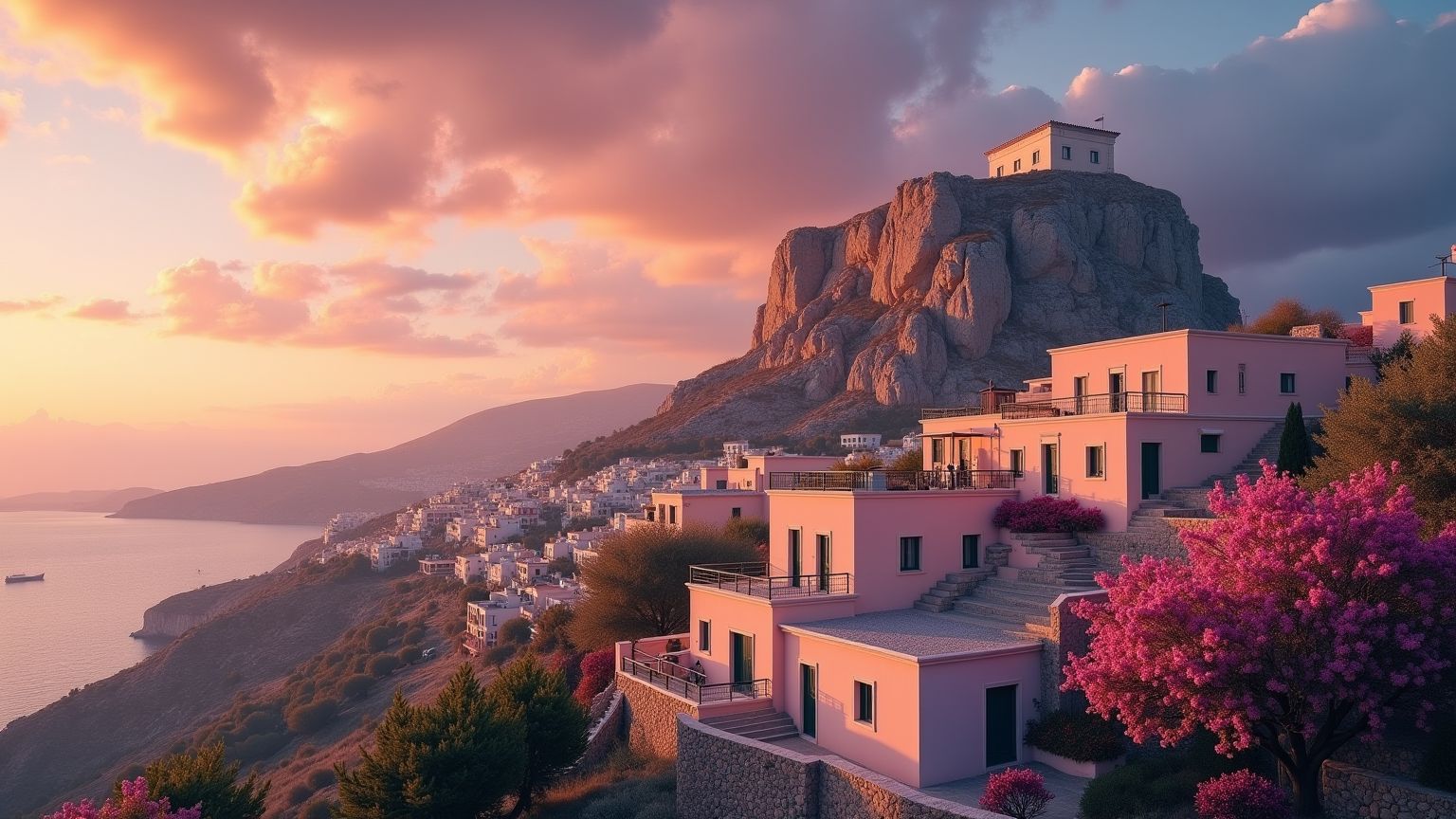Exploring Acrocorinth: A Local Guide to Ancient Corinth’s Spectacular Fortress
I've trudged up that winding path to Acrocorinth at least a thousand times over my 20-year career as a Greek tour guide. Yet somehow, the massive rock fortress still steals my breath clean away—partly from the quad-burning climb, but mostly from those jaw-dropping vistas that unfold like a divine painting.
Once you're standing atop Acrocorinth, with the wind tousling your hair and the whole of ancient Corinth sprawled below, you'll get it—this wasn't just a random military outpost. This was the ultimate power spot where empires planted their flags for over two millennia.
Planning a Peloponnese adventure? Let me tell you why Acrocorinth deserves star billing on your itinerary. I've worn down countless pairs of hiking boots on these storied stones, and I'm itching to spill all my hard-earned secrets about this extraordinary mountaintop citadel.
What is Acrocorinth?

Acrocorinth is nature's perfect fortress—a massive monolithic rock that thrusts dramatically skyward to 575 meters, dominating the landscape like a stone titan. The name literally translates to "Upper Corinth," which is delightfully straightforward Greek logic at work.
This wasn't just some weekend fortress project. Acrocorinth boasts defensive walls stretching nearly 2 kilometers—that's serious ancient real estate! What's truly remarkable about Acrocorinth is its mind-boggling continuity. While other ancient sites had their moment then faded, Acrocorinth kept reinventing itself from archaic Greek times straight through Byzantine glory days, Frankish occupation, Venetian rule, Ottoman dominance, and finally into Greek independence.
I often tell my wide-eyed visitors to think of Acrocorinth as the world's most complicated layer cake, where instead of flour and sugar, each layer is built from the cultural fingerprints of conquering civilizations. Every chipped stone and weathered wall tells a different chapter in Greece's messy, beautiful history.
The Historical Significance of Acrocorinth
Whenever I reach those imposing entrance gates of Acrocorinth with a tour group, I always pause. "Feel that?" I ask. "That's 2,500 years of human drama pressing down on your shoulders."
In its earliest heyday, Acrocorinth belonged to Aphrodite. Yes, THE goddess of love had her temple perched at the summit—and not just any temple. This love shrine reportedly housed over 1,000 temple prostitutes, a fact that reliably makes even my most sophisticated tour groups raise their eyebrows and exchange glances. The ancient writer Strabo wasn't shy about noting that the temple "owned more than a thousand temple slaves, courtesans, whom both men and women had dedicated to the goddess." Ancient Corinth knew how to draw the tourists, even then!
When Christianity swept through like a divine housecleaning, the love temple transformed into a proper church. Later, Ottoman rulers converted it to a mosque. Each religious swap mirrors the fortress itself—constantly changing hands, constantly adapting.
Strategically speaking, Acrocorinth was pure gold. Whoever controlled this rocky giant essentially held the keys to Greece, as it commanded the narrow Isthmus of Corinth—the only land bridge connecting the Peloponnese to mainland Greece. This critical chokepoint for trade and military movements led to the famous ancient saying that Acrocorinth was "the shackles of Greece."
Throughout history, Acrocorinth changed hands more times than a hot potato:
- 🏛️ Byzantine engineers transformed it into an impregnable fortress
- ⚔️ Frankish Crusaders seized it in 1210, adding their distinctive military touches
- 🔄 Byzantines snatched it back in 1395
- ☪️ Ottoman Turks claimed it in 1458, holding it for over two centuries
- 🦁 Venetians conquered it in 1687, leaving their lion emblems as calling cards
- 🔄 Ottomans recaptured it in 1715
- 🇬🇷 Finally, in 1821, Greek revolutionaries liberated their stone giant
Each power grab left architectural fingerprints, creating the spectacular historical mosaic we explore today at Acrocorinth.
What You'll See When Visiting Acrocorinth
The journey to Acrocorinth is half the magic. As your vehicle winds up from modern Corinth, the massive walls gradually reveal themselves, snaking along the ridgeline like a stone dragon sunning itself. Here's your treasure map for what awaits:
The Triple Gates
Your Acrocorinth adventure begins at a defensive masterpiece—three consecutive gates spanning different historical epochs. I love watching visitors' faces as I point out the architectural evolution:
The outer gate stands proudly Ottoman, with its distinctive arches and stonework that whisper tales of turbaned soldiers.
The middle gate screams Venetian military precision—look for the carved stone lion of St. Mark, the ultimate "Venetians were here" graffiti tag of medieval times.
The inner gate hides ancient Greek foundations beneath later additions—massive blocks laid by hands that lived when Socrates still roamed Athens.
Each gate created a lethal trap, where unlucky attackers could find themselves caught between gates, with defenders raining down all manner of unpleasantness from above. Medieval home security at its finest!
The Fortress Walls
The walls of Acrocorinth are like a physical timeline stretched over 2 kilometers. On quiet mornings, when the tourist buses haven't yet arrived, I sometimes run my fingers along sections where Byzantine masons casually incorporated ancient Greek blocks next to their own handiwork.
My insider tip? Walk the northern ramparts early morning when the light is golden and the Gulf of Corinth sparkles below like scattered sapphires. On clear days (usually spring and fall), you can spot the mountains of Attica shimmering in the distance—the same view that sentries watched for approaching armies for centuries.
Religious Buildings
Acrocorinth's spiritual heart reveals its diverse cultural DNA:
Temple of Aphrodite site – Though time hasn't been kind to this love goddess's home, the foundation outlines remain at Acrocorinth's highest point. Standing there on a breezy day, with 360-degree views stretching to seemingly infinite horizons, you'll instantly understand why ancients believed gods must live here. The Mediterranean unfolds in a blue patchwork, making even non-believers feel something transcendent.
Byzantine Church – Nearby sits a humble Byzantine chapel, where fragments of frescoes cling stubbornly to weathered walls. I've seen visitors gasp when sunlight hits just right, illuminating a saint's faded face that has watched over Acrocorinth for a thousand years.
Ottoman Mosque – My personal favorite photo spot in all of Acrocorinth is the small domed Ottoman mosque with its collapsed minaret. Something about its quiet dignity, standing alongside Christian and pagan remains, reminds visitors that Greek history isn't a simple story—it's gloriously complicated.
The Peirene Spring
Want to touch actual mythology? At Acrocorinth, you can. The legendary Peirene Spring—born when Pegasus struck his hoof against the rock—still flows in a cool, dark chamber cut into living stone.
To reach it, you'll navigate slippery stone steps downward, the temperature dropping with each step. The chamber feels otherworldly, with water still seeping from the same source that quenched the thirst of ancient Greek warriors, Byzantine monks, and Ottoman soldiers.
I've watched visitors cup their hands in these mythological waters—the same waters that have flowed without interruption since before Homer put pen to papyrus—and their expressions of wonder are always priceless.
Frankish Keep
At Acrocorinth's southern edge stands the square Frankish tower, a medieval sentinel keeping eternal watch. I often pause here with groups and ask them to close their eyes. "Imagine armored Crusader knights standing right where you are, scanning the horizon for approaching enemy forces, chain mail clinking in the breeze."
This particular spot offers what photographers call "the money shot" of Acrocorinth—the weathered stone tower framed against the vast Peloponnesian landscape stretching to distant mountains.
Practical Tips for Visiting Acrocorinth
After two decades of shepherding everyone from history professors to hyperactive school groups through Acrocorinth, I've assembled some battle-tested advice:
When to Visit
Timing: Tackle Acrocorinth in the morning for two solid reasons. First, you'll dodge the brutal midday heat that turns the exposed fortress into a stone oven, especially June through August. Second, morning light bathes the ancient walls in a photographer's dream glow that makes even smartphone shots look professional.
Season: Acrocorinth shines year-round, but late April through May is pure magic. The fortress walls stand in striking contrast to carpets of wildflowers that somehow find purchase in the rocky soil. The air carries a crystalline clarity that sharpens distant views to postcard perfection.
Duration: Don't short-change yourself—Acrocorinth demands at least 2 solid hours. I can't count how many visitors have made the rookie mistake of allocating just 45 minutes, then frantically rushing through this massive site. History buffs and photographers should block out 3-4 hours minimum to properly commune with this stone behemoth.
What to Bring
- 💧 Water bottles – The ancient cisterns are empty these days, and the site has minimal facilities
- 👟 Serious walking shoes – Those Instagram-perfect sandals will betray you on Acrocorinth's ancient, uneven pathways
- 🧢 Sun protection arsenal – A hat, industrial-strength sunscreen, and sunglasses are non-negotiable (shade is as rare as a friendly Spartan at Acrocorinth)
- 📸 Camera with spare battery – You'll take three times more photos than you expect
- 🍎 Pocket snacks – No ancient Greek food courts here, folks
Navigation and Safety
Acrocorinth isn't your typical velvet-rope archaeological park—it's gloriously wild and unstructured. This freedom to explore is refreshing but can be disorienting. My tested navigation tricks:
Start by following the walls clockwise from the main gates—this creates a natural routing system.
Use the Temple of Aphrodite site at the highest point as your North Star—you can see it from almost anywhere in the fortress.
Respect the ancient stones—certain sections lack modern safety features, and some walls that look climbable are actually unstable after 2,000+ years of weathering.
Keep kids within arm's reach—Acrocorinth wasn't designed with modern liability laws in mind, and some drops are heart-stopping.
After rainfall, those ancient marble and limestone surfaces transform into nature's slip-n-slides. Tread carefully!
Combining with Ancient Corinth
Almost every visitor pairs Acrocorinth with the archaeological site of Ancient Corinth below—and rightly so! These sites complement each other perfectly. Here's my time-tested game plan:
Hit Ancient Corinth first thing in the morning (8:00-10:30), when tour buses haven't yet disgorged their contents. Explore the excellent museum with its stunning artifacts.
Enjoy a languid lunch in Ancient Corinth village—I recommend the taverna with blue chairs under the plane tree, where the moussaka recipe hasn't changed in 40 years.
Climb to Acrocorinth in the afternoon when most tour groups have departed, giving you the fortress almost to yourself as the light turns golden.
The Experience of Visiting Acrocorinth
What makes Acrocorinth truly special transcends historical facts or architectural features—it's the raw, visceral feeling of the place that haunts visitors long after they've returned home.
The silence hits you first. Despite being just a short drive from bustling modern Corinth, Acrocorinth exists in its own sound vacuum. On quieter weekdays, the only soundtrack is the whisper of wind through ancient stones and the distant tinkling of goat bells from the surrounding hillsides.
History feels tangible here in a way that sterile museum displays can never capture. When you run your palm along a wall where ancient Corinthian sentries once stood watch against Spartan invaders, or duck through doorways where Ottoman cavalry once rode, the centuries collapse. At Acrocorinth, history isn't something you read about—it's something you physically touch and feel.
The light at Acrocorinth performs its own daily magic show. Early mornings bring dramatic shadows that accentuate the massive stonework. By midday, the fierce Mediterranean sun reveals every weathered crack and crevice in merciless detail. Late afternoons transform the fortress walls into honey-colored ramparts that seem to glow from within—a photographer's golden hour that has spoiled countless memory cards.
While I could ramble endlessly about historical significance, most visitors tell me they're most affected by Acrocorinth's natural setting. Something about those panoramic views—the vastness of land and sea stretching to seemingly infinite horizons—creates an almost spiritual experience. On clear days, you can trace the outline of distant islands, mountain ranges, and ancient cities all from this single, commanding position. It's a god's-eye view in the most literal sense.
Final Thoughts: Why Acrocorinth Deserves Your Time
In a country drowning in archaeological wonders, Acrocorinth sometimes gets overshadowed by its more famous cousins—the Acropolis of Athens or mystical Delphi. This oversight is actually a gift for travelers hunting authentic experiences away from selfie-stick armies.
What makes Acrocorinth special is its completeness as an experience:
- 🏛️ Mind-boggling archaeological layers spanning multiple civilizations
- 🏰 Military architecture showcasing the evolution of "how to build an impregnable fortress 101"
- 🌄 Heart-stopping natural beauty that no Instagram filter can improve
- 🏺 Tangible connections to Greek mythology where legends literally left footprints
- 🔍 The rare joy of personal discovery in an increasingly over-curated travel world
When visitors timidly ask if Acrocorinth is "worth it," I can't help but laugh. Unlike those velvet-rope archaeological parks where you follow prescribed paths with informational signage every three steps, Acrocorinth retains a delicious wildness. This isn't history behind glass—it's history you climb, touch, and experience with all your senses.
For those willing to put in the legwork, Acrocorinth offers something vanishingly rare in our modern world—the chance to step off the tourist conveyor belt and discover history on your own terms. As you stand atop this ancient citadel that has witnessed empires rise and fall, looking out across vistas that have captivated human eyes for millennia, you'll understand why Acrocorinth has been worth fighting for—and now worth preserving—throughout the ages.
The massive stone sentinel of Acrocorinth has stood watch for over 2,500 years. Give it at least a few hours of your Greek adventure. You won't regret it.
🏺 Discover Ancient Greece With Expert Guides
Transform your historical knowledge into unforgettable archaeological experiences
Historical Tours
UNESCO Archaeological Sites
Peloponnese Tours
25+ Local Experiences
Adventure Tours
Outdoor Activities








